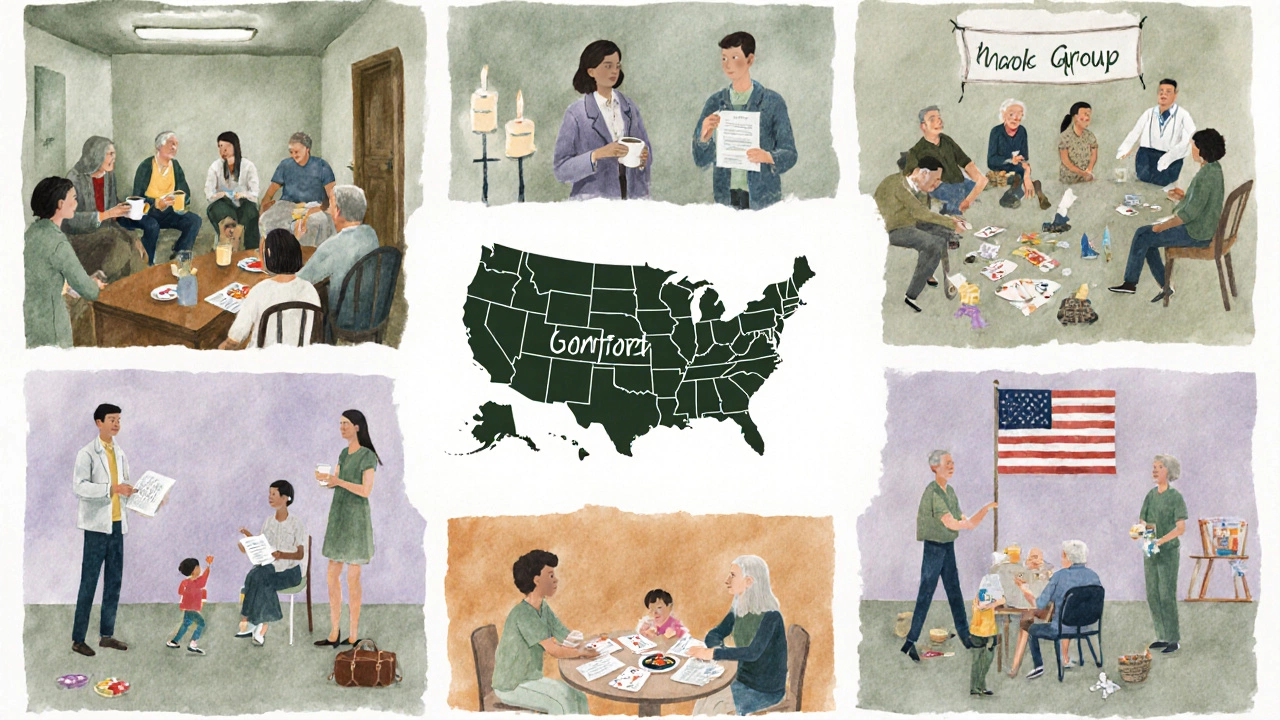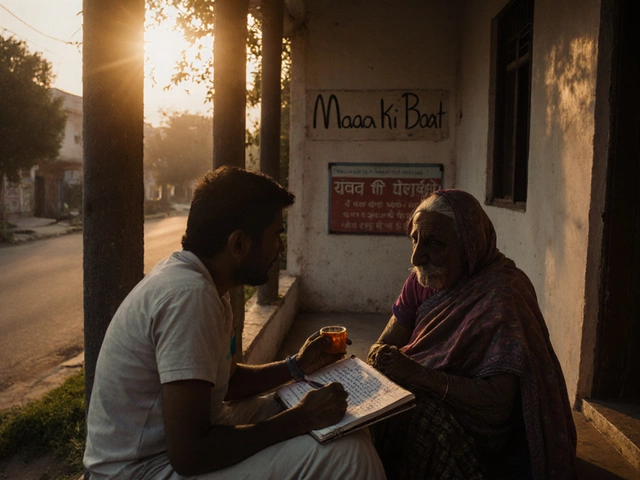Support Group Identifier
What Makes a Genuine Support Group?
Use this tool to evaluate if a gathering meets the essential criteria of a support group. Enter details about the group below to see if it qualifies.
Common Support Group Examples
Alcoholics Anonymous (AA)
12-step fellowship for people who want to stop drinking. Meetings focus on sharing personal stories, reading AA literature, and offering accountability.
Grief Support Group
Brings together individuals coping with loss (death of a loved one, divorce, etc.). Sessions usually include guided discussions and coping-skill exercises.
Chronic Illness Peer Group
Connects people living with conditions like diabetes, multiple sclerosis, or rheumatoid arthritis. Members trade practical tips and emotional encouragement.
Parenting Support Circle
Safe space for parents of newborns, teens, or children with special needs to discuss challenges, share resources, and reduce isolation.
Ever wondered what actually counts as a support group example? Maybe you’ve heard the term tossed around in a friend’s story, a school newsletter, or a community flyer, but you’re not sure which kind of gathering truly fits the label. Below you’ll get a plain‑language definition, a handful of real‑world examples, tips on spotting a legit group, and a quick guide to getting involved.
What a Support Group Really Is
Support group is a regularly scheduled gathering of people who share a common challenge, experience, or goal, and who meet to exchange emotional, informational, or practical help. Unlike a club that focuses on a hobby or a class that teaches a skill, a support group’s core purpose is peer‑to‑peer encouragement and shared learning.
Key Features That Separate a Support Group from Other Gatherings
- Members face a similar life circumstance (e.g., grief, addiction, chronic illness).
- Meetings are usually free or low‑cost and open to anyone in the target group.
- Conversation is confidential - what’s said stays within the group.
- Facilitation can be led by a professional, a trained peer, or a volunteer.
Common Real‑World Examples
Below are six widely recognized formats. Each one fits the definition above, making them solid support group examples you might encounter in your community.
- Alcoholics Anonymous (AA) - a 12‑step fellowship for people who want to stop drinking. Meetings focus on sharing personal stories, reading the AA literature, and offering accountability.
- Grief Support Group - brings together individuals coping with loss (death of a loved one, divorce, etc.). Sessions usually include guided discussions and coping‑skill exercises.
- Chronic Illness Peer Group - connects people living with conditions like diabetes, multiple sclerosis, or rheumatoid arthritis. Members trade practical tips (diet, medication management) and emotional encouragement.
- Parenting Support Circle - a safe space for parents of newborns, teens, or children with special needs to discuss challenges, share resources, and reduce isolation.
- Peer Counseling Group - run by trained volunteers, this format pairs members who have lived through similar hardships (e.g., survivors of domestic violence) to provide mutual aid.
- Community Center Wellness Club - while not always labeled a “support group,” many local centers host weekly meet‑ups for seniors, veterans, or LGBTQ+ individuals that function exactly like peer‑support circles.

How to Spot a Legitimate Support Group
When you’re scanning a flyer or a website, ask yourself these quick questions:
- Who runs the group? Look for a named facilitator, a sponsoring organization, or a clear peer‑lead structure.
- Is there a clear focus? Vague “social meetup” language can mask a non‑support gathering.
- Are meetings regular? Consistency (weekly, bi‑weekly, monthly) signals commitment.
- Is confidentiality mentioned? A statement about privacy shows the group values safe sharing.
- Is there a cost? Most genuine groups are free or ask only for a small donation to cover space.
Steps to Join a Support Group
- Identify your need - whether it’s coping with grief, managing a health condition, or simply needing peer encouragement.
- Search locally - use community bulletin boards, libraries, hospital outreach pages, or online directories like Meetup and Facebook Groups.
- Read the group description - confirm that the focus matches your situation and that the meeting format feels comfortable.
- Reach out - send a brief email or call the contact person to ask about the first meeting, any registration steps, and what to expect.
- Attend the intro session - treat it like a trial. Observe the vibe, how members interact, and whether you feel heard.
- Commit if it feels right - many groups welcome ongoing participation, but you can always try another if it’s not a fit.
Benefits You Can Expect
Research from the National Institute of Mental Health shows that regular participation in peer support groups reduces feelings of isolation by up to 40% and improves coping scores for chronic conditions by roughly 30%.
- Emotional relief: Sharing reduces the burden of carrying concerns alone.
- Practical knowledge: Members swap tips that you won’t find in a brochure.
- Motivation boost: Seeing others make progress can spark your own momentum.
- Accountability: Regular check‑ins keep you honest about goals (e.g., staying sober).
- Social connections: Even a brief hello can evolve into lasting friendships.
Common Pitfalls and How to Avoid Them
Even good groups can run into trouble. Here’s what to watch for and quick fixes.
| Pitfall | Why It Happens | Prevention |
|---|---|---|
| Dominating personalities | People feel compelled to steer conversation. | Facilitator sets clear speaking rules and uses a “talking stick.” |
| Confidentiality breaches | Members share stories outside the room. | Remind group of privacy policy at every meeting. |
| Irregular attendance | Members lose momentum. | Schedule meetings at a consistent day/time; send reminders. |
| Lack of professional guidance when needed | Complex issues exceed peer expertise. | Invite mental‑health professionals for occasional workshops. |
Where to Find Support Groups Near You
In Wellington, several venues host active groups:
- Wellington Community Centre - offers weekly grief and chronic‑illness circles.
- St. James Hospital - runs AA meetings and diabetes peer groups.
- Te Papa Museum Café - hosts a monthly parenting support circle.
- Local libraries - bulletin boards list free meet‑ups for veterans and LGBTQ+ youth.
If you’re outside New Zealand, replace the names with your city’s community hub, hospital outreach department, or municipal library.
Frequently Asked Questions
Is a support group the same as therapy?
Not exactly. Therapy involves a licensed professional diagnosing and treating mental health issues, while a support group is peer‑led and focuses on shared experiences. Many people attend both for complementary benefits.
Do I need to share my story right away?
No. Most groups allow newcomers to listen first. Share only when you feel ready; the environment is meant to be low‑pressure.
Can I start my own support group?
Absolutely. Identify a clear focus, secure a safe meeting space (library rooms are often free), set simple confidentiality guidelines, and advertise through local noticeboards or online platforms.
What if the group isn’t a good fit?
It’s okay to leave. Treat the first few meetings as a trial period. Look for another group whose vibe, size, or meeting style matches you better.
Are virtual support groups as effective as in‑person ones?
Research shows virtual groups can be just as supportive, especially when participants have mobility issues or live in remote areas. The key is reliable technology and a clear set of ground rules.






